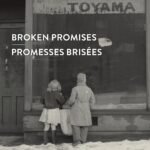Naoko Matsubara + Alexa Hatanaka
> read moreArchives
Understanding Forgiveness (赦し)
Adapted from the Nikkei National Museum exhibits Taiken and Hastings Park 1942 as a companion to the Arts Club Theatre Company’s 2023 production of Forgiveness.
> read moreWhere Songs Surface
詩が生まれる場所
Masako Miyazaki + Yoshimi Lee.
March 18-Sep 16, 2023
TAIKEN: Generations of Resilience
Permanent exhibit. Explore Japanese Canadian history and continuing heritage on the walls of the upper level at the Nikkei Centre.
> read moreWomen of Change: Celebrating Japanese Canadian Leaders
Meet 6 Japanese Canadian women leaders who upheld the community for over a century.
> read moreJapanese Design Today 100 | 現代日本のデザイン100選
May 7 – June 26, 2022
> read moreSAFE | HOME
October 26, 2021 – April 30, 2022
> read moreWriting Wrongs: Japanese Canadian Protest Letters of the 1940s
Writing Wrongs is inspired by over 300 letters written by Japanese Canadians in the 1940s to protest the Canadian government’s forcible sale of their property.
> read moreIron Willed: Women in STEM
July 10 – October 2, 2021
> read moreBroken Promises
Dispossession of Japanese Canadians in the 1940s.
September 2020 – June 27, 2021










